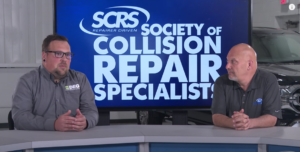
Collision repair experts share consumer tips on OEM procedures
By onCollision Repair | Insurance | Repair Operations
A series of recent “Quick Tips” videos recently released by the Society of Collision Repair Specialists (SCRS) aim to help consumers better understand the importance of original equipment manufacturer (OEM) parts.
Here’s a roundup of the tips posted on SCRS’ YouTube channel:
OEM procedures
In one video, collision experts discussed the importance of following OEM procedures, saying doing so has become especially important as vehicles become more complex.
Consumers seeking repairs should hire technicians that use OEM repair manuals to guide their work, said Danny Gredinberg, administrator of Data Enhancement Gateway (DEG).
He likened using non-OEM procedures to assembling a Lego set without the manual.
“As a technician myself, I’d be lost without OEM repair procedures,” Gredinberg said. “If you have ever put together a Lego kit, you know you have a million little pieces. But without the instruction manual, they’d be all over the floor and you’d be stepping on them. By following those [correct] procedures, …I can have a functional toy.”
It’s important for consumers to ask repair shops questions, including whether they follow OEM procedures, and have the necessary equipment and training, he said.
Joining him in conversation was Mike Anderson, owner of Collision Advice, who said OEM procedures should be considered non-negotiable.
“They must be followed to the T,” Anderson said. “And it’s not only important that you choose a collision repair facility that will follow the procedures, but also that you ask your insurance carrier: ‘Does your policy language cover following all of OEM repair procedures?’”
OEM coverage
Not all insurers cover OEM parts, so it’s important for consumers to shop around for the right policy before committing, Anderson said.
While some carriers could refuse to fund OEM repairs altogether, others might agree to cover original parts for a small fee. Sometimes, consumers have to request it in order to have it added to their policy, Anderson said.
Drivers should also clarify with insurers whether an OEM parts stipulation includes windshield repairs or replacements, he said.
Gredinberg said that for as little as it costs to add OEM coverage to policies, there’s no reason drivers shouldn’t go with an insurer that offers it.
“[Original parts are] what they would expect to be in their vehicle,” he said. “They’re crash tested, they’re warrantied by the manufacturer. The fit and finish is great on these parts.”
Conversely, he added that when drivers opt to forego OEM replacement parts, they’ll “be losing quality, genuine parts in your vehicle.”
OEM vs opt OEM
Anderson acknowledged that it can be confusing for those outside the industry to tell the difference between OEM parts and opt OEM parts.
However, he said, it’s an important distinction.
“An OEM part is a part that has been sold to the collision repair facility from the dealership on behalf of the vehicle manufacturer,” he said. “[With] opt OEM parts, the ‘opt’ stands for optional. That is a part that someone is claiming is an OEM part, but it has not been sold to the collision repair facility through a dealership channel.”
Approving opt OEM repairs could be an issue for those whose vehicles are still under warranty, Anderson added.
“Right now I understand that dealers will only warranty OEMs; will only warranty parts sold through their dealership channel,” he said. “The warranty on an opt OEM part may be different than that bolt from the dealership. It’s really important as a consumer you understand the difference.
“At the end of the day, remember as a consumer, you sign the repair authorization and you choose what parts go on your vehicle.”
IMAGE
Featured image credit: NickyLloyd/iStock
